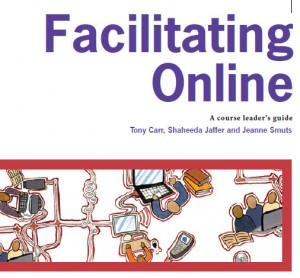Thanks to Jeff Lebow, there is a recording, synched to my slides, of Friday’s presentation as part of Webheads in Action Online unConvergence. Sweet! I have also copied in the text with some of the slides below. I also learned the slide set on Slideshare was featured today! Fun!
Notes:
- Slide 5 : These roles and practices create the conditions that enable people to….
- Slide 6: This activity comes out of a chapter in our book that looks at the activity orientations of communities of practice and how this might drive both the technology stewardship and the overall community nurturing and leadership activities. In this context, we are using it to explore the application of social media to a particular goal you might have.
- Slide 7: In our research of CoPs we noticed 9 general patterns of activities that characterized a community’s orientation. Most had a mix, but some were more prominent in every case.Image: Wenger, White and Smith, 2007
- Slide 8: Before you do the Spidergram exercise, read through the orientations and think of some examples from a number of contexts. I’ll offer two examples as well in subsequent slides.
- Slide 9: Here is an example drawn from the book “Red-Tails in Love: Pale Male’s Story — A True Wildlife Drama in Central Park” by Marie Winn. Vintage Books, 2005. The book tells of a community of bird watchers in Central Park and exquisitely describes their practices. This is a predominantly face to face group that might use some social media, but not as their central way of interacting. They are a large, diverse group, but tightly geographically bound to Central Park in New York City. They might fill this spidergram differently than I might, but this is just an example! Image: Wenger, White and Smith, 2007
- Slide 10: KM4Dev (http://www.km4dev.org) is a global network of practitioners interested in knowledge management and knowledge sharing in international development. Over 800 members are subscribed to the email list which had it’s origins in July 2000. It is both a well established but loosely bounded network that interacts primarily online, with once a year meetings that a small subset attend.
- What was interesting was that these orientations had implications beyond communities. They could be a useful analysis, diagnostic and measurement tool for the application of social media to an organization’s work. What was interesting was that these orientations had implications beyond communities. They could be a useful analysis, diagnostic and measurement tool for the application of social media to an organization’s work.
- Slide 12: You can see how different groups have different priorities. It is a bit like a community activity “finger print.” The next step is to think about what tools support the different orientations.
- Slide 13: Here are some examples of social media tools that support the orientations. Keep in mind that while a tool may have been designed for a specific purpose, people regularly and imaginatively use them in different ways.
- Slide 14: A tech steward may be called upon to make sense of all the offerings of the market, scanning and selecting for her community. They start paying attention to working with the tensions between the individual and the group, synch and asynch group, interacting and publishing. Image credit: Wenger, White and Smith
- Slide 15: Sliders – as we think about how we pick, design and deploy technology, what sort of intentionality do we want with respect to these tensions? More importantly, how do we use them as ways to track our community’s health, make adjustments in both technology and practice.
- Slide 16: What would your Spidergram look like? Think of a specific group or project that you want to explore. What activities do you need to support? Which are more important than others? Put a mark on the arrow to indicate how important a particular orientation is to your community. The more important the orientation, the further out on the arrow the dot should be placed. Then draw a line between the dots. Clarification: For context, towards the middle means a more inward (private) orientation and towards the outer edge a more public/open orientation.Discuss the spidergram with your group or community. Do they see it differently? Adjust your image to get the fullest view possible. Then, and only then, start thinking about tools. Always start with WHAT you want to do before the HOW!
- Slide 17: Here is a blank template for you. You can do it in PowerPoint or print it off, do it by hand then scan or take a digital image to share back online with the rest of the group. Put a mark on the arrow to indicate how important a particular orientation is to your community. The more important the orientation, the further out on the arrow the dot should be placed. Then draw a line between the dots. See the next example.
- Slide 18: Let’s brainstorm some examples of social media tools that support the orientations. Keep in mind that while a tool may have been designed for a specific purpose, people regularly and imaginatively use them in different ways.

